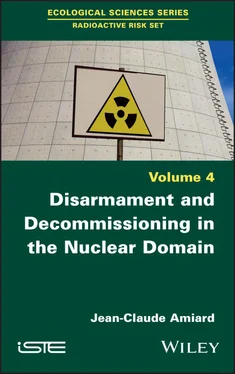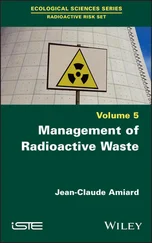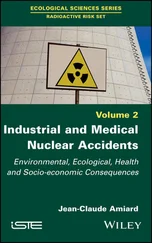1 Cover
2 Title Page Radioactive Risk Set coordinated by Jean-Claude Amiard
3 Copyright First published 2021 in Great Britain and the United States by ISTE Ltd and John Wiley & Sons, Inc. Apart from any fair dealing for the purposes of research or private study, or criticism or review, as permitted under the Copyright, Designs and Patents Act 1988, this publication may only be reproduced, stored or transmitted, in any form or by any means, with the prior permission in writing of the publishers, or in the case of reprographic reproduction in accordance with the terms and licenses issued by the CLA. Enquiries concerning reproduction outside these terms should be sent to the publishers at the undermentioned address: ISTE Ltd 27-37 St George’s Road London SW19 4EU UK www.iste.co.uk John Wiley & Sons, Inc. 111 River Street Hoboken, NJ 07030 USA www.wiley.com © ISTE Ltd 2021 The rights of Jean-Claude Amiard to be identified as the author of this work have been asserted by him in accordance with the Copyright, Designs and Patents Act 1988. Library of Congress Control Number: 2021938220 British Library Cataloguing-in-Publication Data A CIP record for this book is available from the British Library ISBN 978-1-78630-721-7
4 Preface
5 Acknowledgments
6 1 Nuclear Non-Proliferation
1.1. Introduction 1.2. The first countries to acquire the atomic bomb 1.3. The NPT 1.4. Other nuclear non-proliferation treaties 1.5. Disarmament controls 1.6. Actions of NGOs 1.7. The military denuclearization of a state 1.8. Conclusions
7 2 Disarmament of Atomic Weapons2.1. Introduction 2.2. Limitations on the number of nuclear weapons 2.3. Nuclear deterrent forces 2.4. Disarmament controls 2.5. Conclusions
8 3 International Recommendations and National Policies in Decommissioning3.1. Introduction 3.2. General principles of decommissioning and dismantling 3.3. Lessons from the past 3.4. The decommissioning and dismantling policies of the various states 3.5. Conclusions
9 4 Procedures and Technologies Involved in Decommissioning4.1. Introduction 4.2. The cost of dismantling 4.3. The production of radioactive waste 4.4. The environmental and health risks of dismantling 4.5. Nuclear decommissioning techniques 4.6. Technical innovations in nuclear decommissioning 4.7. Conclusions
10 5 The Dismantling of Military Nuclear Facilities5.1. Introduction 5.2. The decommissioning of military plants at the beginning of the nuclear fuel cycle 5.3. The decommissioning of military spent fuel reprocessing plants 5.4. Decommissioning and decontamination of military sites 5.5. The destruction of atomic weapons and their vectors 5.6. Conclusions
11 6 The Dismantling of Electronuclear Reactors6.1. Introduction 6.2. The dismantling of graphite-moderated reactors 6.3. The dismantling of the pressurized water system (PWR) 6.4. Dismantling the heavy water sector 6.5. Dismantling of the boiling water reactor sector 6.6. Dismantling following a nuclear accident 6.7. Future reactor shutdowns 6.8. Conclusions
12 7 The Decommissioning of Research Reactors and Other Basic Nuclear Facilities7.1. Introduction 7.2. The dismantling of experimental reactors around the world 7.3. Decommissioning and dismantling of fourth-generation reactors 7.4. The dismantling of first-generation prototype reactors 7.5. The dismantling of basic nuclear fuel cycle facilities 7.6. Decommissioning of other basic nuclear facilities 7.7. Conclusions
13 General ConclusionsC.1. The failure of non-proliferation C.2. The rejection of the concept of nuclear deterrence C.3. The failure of nuclear disarmament C.4. An impressive dismantling market C.5. International recommendations for decommissioning C.6. National decommissioning policies C.7. Problems in dismantling of French power reactors C.8. Results of dismantling BNIs C.9. Specificities of nuclear facility decommissioning
14 List of Acronyms
15 References
16 Index
17 End User License Agreement
1 Chapter 1 Figure 1.1. The United Nations organization. For a color version of this figure,... Figure 1.2. The various UN bodies working on non-proliferation and disarmament. ... Figure 1.3. The various regional treaties banning nuclear weapons. For a color v... Figure 1.4. Organizational structure of the South African nuclear program accord...
2 Chapter 2 Figure 2.1. Various types of atomic bombs. For a color version of this figure, s...
3 Chapter 3Figure 3.1. The various phases in the life of a basic nuclear installation (sour...Figure 3.2. The various stages of the decommissioning and dismantling of a nucle...Figure 3.3. The three phases of a nuclear facility: operation, transition and de...Figure 3.4. The decommissioning and dismantling process of nuclear facilities in...Figure 3.5. Diagram of the decommissioning phases according to the Swedish licen...
4 Chapter 4Figure 4.1. Overview of the estimate by calculating the cost of decommissioning ...Figure 4.2. Example of a probability versus impact diagram (source: [IAE 19c]). ...Figure 4.3. Decommissioning operations and environmental and health impact asses...Figure 4.4. Risks associated with the various phases of decommissioning (source:...Figure 4.5. Relationships between the parties involved in the decommissioning an...
5 Chapter 5Figure 5.1. Internal zone problems with the various study areas and contaminants...Figure 5.2. Main elements of the Hanford clean-up completion framework, the Rive...
1 Chapter 2 Table 2.1. Strategic forces bomb vectors in January 2018 [SIP 18]. * The first n... Table 2.2. Components of nuclear power and number of nuclear warheads in 2017 Table 2.3. Temporal changes in nuclear weapons stockpiles in 2009, 2013, 2017 an... Table 2.4. Stocks of highly enriched uranium (in tonnes) at the end of 2012 (sou... Table 2.5. World stock of enriched uranium in 2017 (source: [KÜT 19]) Table 2.6. Stocks of plutonium (in tonnes) at the end of 2012 (source: [FEI 14]) Table 2.7. Global stockpile of military and civilian plutonium (source: [KÜT 19]...
2 Chapter 3Table 3.1. Duration of decommissioning of several nuclear power reactors (source...Table 3.2. Selected decommissioning projects (source: [LAR 18a])Table 3.3. Russian nuclear facilities in decommissioning stage (source: [NEA 18b...
3 Chapter 4Table 4.1. Contribution (%) of decommissioning and waste management phases to th...Table 4.2. Decommissioning costs (in US dollars per installed kWe) of reactors b...Table 4.3. Quantity of nuclear waste (in tons per installed MWe) by reactor type...Table 4.4. US Department of Energy 2018, 2019 and 2020 Nuclear Budgets in thousa...Table 4.5. Estimated life cycle financial data for each UK site (based on [NDA 0...Table 4.6. Evolution of NDA cost estimates for the decommissioning and cleanup o...Table 4.7. Quantities and fate of nuclear waste from the decommissioning of the ...Table 4.8. Quantities of material that can be released (based on [SEL 12])Table 4.9. Proposed EURATOM release thresholds as a function of mass activity (b...Table 4.10. Example of a probability scale for the use of risk analysis (modifie...Table 4.11. Example of an impact scale for the use of risk analysis (source: [IA...Table 4.12. Soil release thresholds for US sites (NRC Derived Concentration Guid...Table 4.13. Prescribed site release thresholds adopted by Germany [STR 01]. The ...Table 4.14. Performance of various cutting techniques (source: [STE 12]). *EDM: ...Table 4.15. The different “products” according to the life cycle of a nuclear in...
4 Chapter 5Table 5.1. Closures of military uranium enrichment plants (source: [FEI 14])Table 5.2. Military enrichment plants in operation in 2013 (source: [FEI 14]). C...Table 5.3. American plutonium-producing reactors at the Hanford site (source: [F...Table 5.4. US plutonium-producing reactors at the Savannah River site (source: [...Table 5.5. Closures of military reprocessing plants (source: [FEI 14])Table 5.6. Worldwide military reprocessing plants in operation in 2013 (source: ...Table 5.7. Environmental contamination in the United States from nuclear facilit...Table 5.8. Dates and measures for cleaning waste in the tanks (source: [USD 13])Table 5.9. Nuclear facilities undergoing decommissioning in various areas of the...Table 5.10. Quantities of cesium-137 and iodine-131 present in various structure...Table 5.11. Russian fuel fabrication and research and development (R&D) faciliti...Table 5.12. Cost in millions of US dollars for the inactivation and decommission...Table 5.13. Gamma radiation (γ) and beta radiation (β) contamination levels on t...Table 5.14. Russian submarines shut down and being decommissioned in 2001 (sourc...Table 5.15. Northern fleet submarines shut down and stored in 1997 (source: [ØLG...Table 5.16. Composition of liquid radioactive wastes according to their location...
Читать дальше











